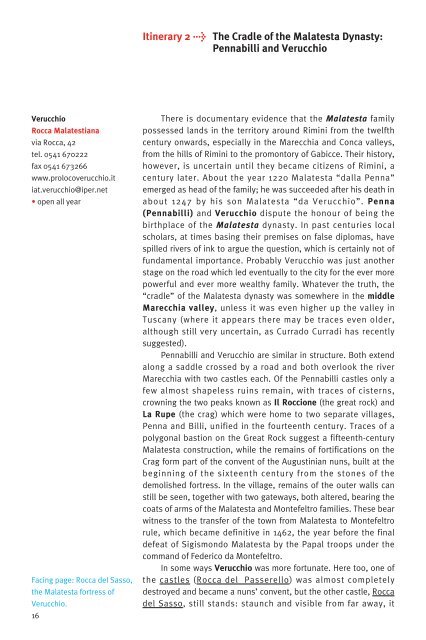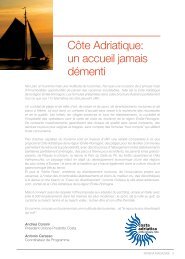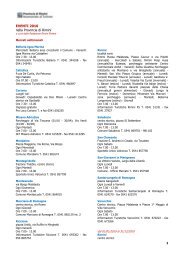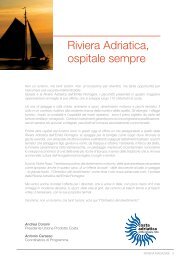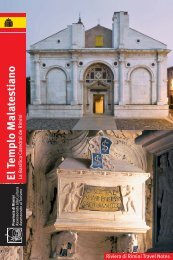Malatesta fortresses and castles
Malatesta fortresses and castles
Malatesta fortresses and castles
- No tags were found...
Create successful ePaper yourself
Turn your PDF publications into a flip-book with our unique Google optimized e-Paper software.
Itinerary 2 > The Cradle of the <strong>Malatesta</strong> Dynasty:Pennabilli <strong>and</strong> VerucchioVerucchioRocca Malatestianavia Rocca, 42tel. 0541 670222fax 0541 673266www.prolocoverucchio.itiat.verucchio@iper.net• open all yearFacing page: Rocca del Sasso,the <strong>Malatesta</strong> fortress ofVerucchio.16There is documentary evidence that the <strong>Malatesta</strong> familypossessed l<strong>and</strong>s in the territory around Rimini from the twelfthcentury onwards, especially in the Marecchia <strong>and</strong> Conca valleys,from the hills of Rimini to the promontory of Gabicce. Their history,however, is uncertain until they became citizens of Rimini, acentury later. About the year 1220 <strong>Malatesta</strong> “dalla Penna”emerged as head of the family; he was succeeded after his death inabout 1247 by his son <strong>Malatesta</strong> “da Verucchio”. Penna(Pennabilli) <strong>and</strong> Verucchio dispute the honour of being thebirthplace of the <strong>Malatesta</strong> dynasty. In past centuries localscholars, at times basing their premises on false diplomas, havespilled rivers of ink to argue the question, which is certainly not offundamental importance. Probably Verucchio was just anotherstage on the road which led eventually to the city for the ever morepowerful <strong>and</strong> ever more wealthy family. Whatever the truth, the“cradle” of the <strong>Malatesta</strong> dynasty was somewhere in the middleMarecchia valley, unless it was even higher up the valley inTuscany (where it appears there may be traces even older,although still very uncertain, as Currado Curradi has recentlysuggested).Pennabilli <strong>and</strong> Verucchio are similar in structure. Both extendalong a saddle crossed by a road <strong>and</strong> both overlook the riverMarecchia with two <strong>castles</strong> each. Of the Pennabilli <strong>castles</strong> only afew almost shapeless ruins remain, with traces of cisterns,crowning the two peaks known as Il Roccione (the great rock) <strong>and</strong>La Rupe (the crag) which were home to two separate villages,Penna <strong>and</strong> Billi, unified in the fourteenth century. Traces of apolygonal bastion on the Great Rock suggest a fifteenth-century<strong>Malatesta</strong> construction, while the remains of fortifications on theCrag form part of the convent of the Augustinian nuns, built at thebeginning of the sixteenth century from the stones of thedemolished fortress. In the village, remains of the outer walls canstill be seen, together with two gateways, both altered, bearing thecoats of arms of the <strong>Malatesta</strong> <strong>and</strong> Montefeltro families. These bearwitness to the transfer of the town from <strong>Malatesta</strong> to Montefeltrorule, which became definitive in 1462, the year before the finaldefeat of Sigismondo <strong>Malatesta</strong> by the Papal troops under thecomm<strong>and</strong> of Federico da Montefeltro.In some ways Verucchio was more fortunate. Here too, one ofthe <strong>castles</strong> (Rocca del Passerello) was almost completelydestroyed <strong>and</strong> became a nuns’ convent, but the other castle, Roccadel Sasso, still st<strong>and</strong>s: staunch <strong>and</strong> visible from far away, it


